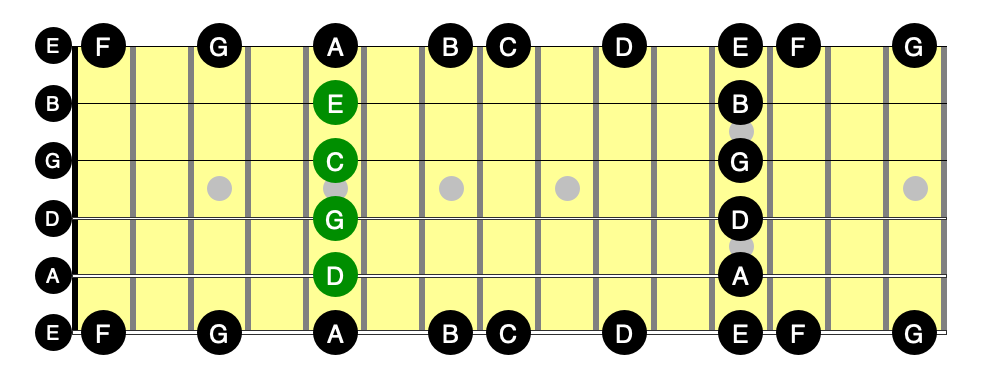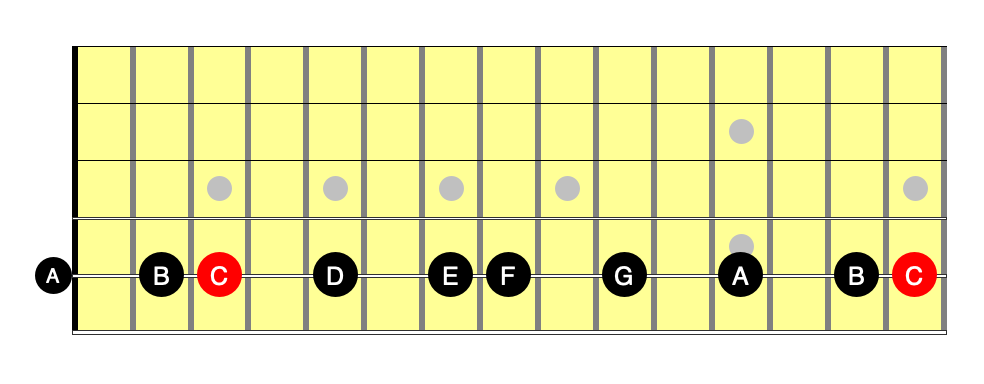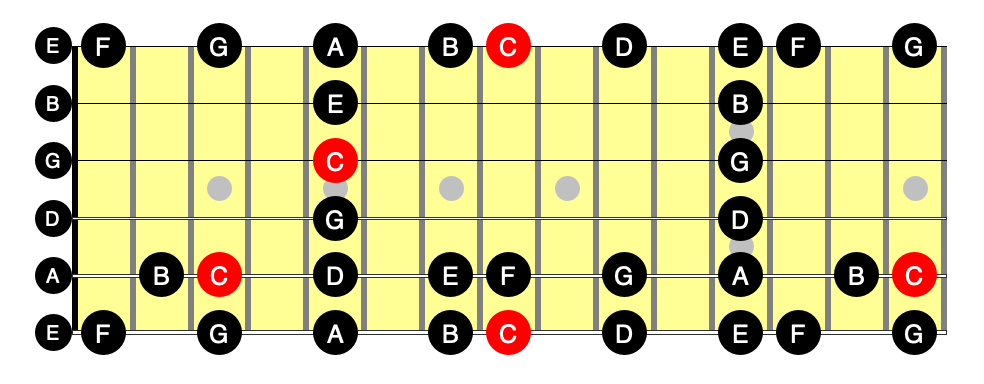Let’s get a few more notes under our fingers and into our brains.
This is part 4 of 6 about learning the notes on the fretboard:
- Just 12 notes. (Background material)
- Open and E strings
- Practicing with actual songs
- Fret 5 and String 5 (this page)
- Octave Shapes
- Whole Fretboard
As we described previously, if we KNOW the notes of the open strings and at the 12th fret, it’s handy to also KNOW the notes at the 5th fret because it’s almost half way between. By learning just four more notes, we can pretty much ensure that no matter where we place our hand, we can find at least one KNOWN location for any given note without reaching too far.
The new notes we are going to learn are shown in green.
The goal, of course, is to KNOW these notes just as well as the open strings or notes on the E string. Before you get things totally programmed, though, there’s a little trick you can use to remember these notes.
Notice the order of the notes going across the strings at the fifth fret, low to high: A D G C E A. The order of those notes should sound vaguely familiar (hint: they are in fourths, except for C to E which is an interval of a major third).
Yup, it’s very similar to the order of the open strings, just shifted by one. Instead of an E on the outside two strings, we have an A at the fifth fret.
The open 5th, 4th, and 3rd strings are the notes A D G. At the fifth fret, it’s strings 6, 5, and 4 that give you A D G.
In fact, the bottom 5 strings at fret five are almost the same notes as the top five open strings. The one exception is the note C on the third string.
Because of the tuning exception between the 3rd and 2nd strings (a M3 instead of a p4) Since the ADGBE pattern on the open strings shifts to lower strings at fret 5 that are tuned in fourths, the B has to move up a semitone and becomes a C. All the other notes stay the same. Since the outside notes are tuned the same, of course, the note on the outside strings at every fret is the same (both A’s at fret 5).
Anyway, this “trick” of the same sequence of notes as the open strings may be enough to jog your memory at first. The goal, however, is to avoid tricks and memory jogs eventually: you simply want to KNOW every note at the 5th fret, effortlessly, without any conscious thought.
My advice is to really focus on that note C at string 3, fret 5. Try to turn that into a KNOWN landmark as quickly as possible. In general, my advice for anything to do with guitar or music is to focus on the hardest things (and the exceptions) first. None of it is easy, but if you get the hard bits out of the way it’s not as overwhelming.
In practice, the outermost strings invariably get the most practice (because of barre chords with the roots in the bass, and because soloing mostly uses the higher registers). That means you’ll soon KNOW the notes on the E strings almost automatically as you learn songs.
Learning the innermost strings (3 and 4, the G and D strings) is much harder in practice than the outer strings. Most people (myself included) rely on dead reckoning for notes on the inner strings for years. The more landmarks you truly KNOW in the middle, the easier the dead reckoning for other notes. If you truly KNOW at least one or two notes on each string, finding the remaining ones is a whole lot easier.
Anyway, I recommend turning that C on the G string into a landmark that you KNOW as quickly as possible. Whenever you think or hear “C” you should visualize fretting that note. Whenever your hand is anywhere around the 5th fret, you should almost see a big bright red “C” hovering over the fretboard in that location.
Exercise 11: Fret 5 drills
Play each note at the 5th fret in order, slowly and purposefully. Play the A on string 6 and say "This is an A" out loud. Next play the D on the 5th string. Now go back down the strings, starting with the first string. Really focus on the sound and location. Try to visualize each note sort of hovering above the fretboard.
By the way: precious few people have perfect pitch, but I'm dead serious about paying attention to the sound of the notes. Playing notes across a fret like this subconsciously trains your ear to hear the sounds of p4 and p5 intervals if nothing else. Every note you play is heard in the context of every other note on the guitar.
It amazed me how much better I got at hearing wrong notes after learning the fretboard. I used to be amazed at pros tuning a string mid-song. Now, even I can tell almost immediately when a string is slightly out of tune. Believe it or not, the more you do these kinds of drills the better your ear will get. This is why it's so important to tune up at the start of every practice session! You don't want to train your subconscious on out-of-tune notes.
Next, go through the mostly-fourths sequence (BEADGCF) repeatedly, one note at a time. If the note exists on the fifth fret, play it and say the note name out loud. If it's an A, play either one you like. If it's not on the fifth fret, play it on either one of the outer strings anywhere you can find it (including way up high on the neck). Make sure you play A, D, G, C, and E at the fifth fret!
Repeat the exercise using triad sequences: CEG, BDF, ACE, GBD, FAC, EGB, DFA.
Don’t be in a rush! Memorization takes time and lots and lots and lots of repetition. It can be boring when it seems easy, but trust me it’s still worthwhile. Every note we add makes the process harder and harder — the more time and effort (and repetitions!) you spend with the easy, early stuff, the easier the later stuff will be.
Don’t move on until you are absolutely confident that you can quickly and easily find any note we’ve covered so far. It’s perfectly fine if this takes several days or even weeks. Just keep at it.
Know that even a few minutes a day, for 4 to 7 days a week is far better than multi-hour marathon sessions every few weeks. It’s almost impossible to make progress on the instrument without regular practice. Life intrudes for all of us, but you make time for that which is important to you. If you are unavoidably away from your guitar for a week or more, practice things that don’t need your guitar (like memorizing the cycle of fourths, the notes in triads and four-note chords, or which chords are diatonic to each key).
String 5
We’re finally going to pick up the pace a little now.
I can hear the relieved cheering, but don’t say I didn’t warn you!
Here are all the natural notes on string 5:
Remember, you already KNOW the notes on the open string, 5th fret, and 12th fret. Ignoring the frets above 12 for now (the pattern just repeats) that means we’re adding a whopping ten new notes in one swell foop.
The pattern is still the same though. It’s still the good ole C Major scale, with whole steps between every note except B/C and E/F.
Exercise 12: String 5 focused drills
We'll use the same technique we used previously. Start with the notes that are only one degree away from notes we already KNOW. Those notes are B, C, E, and G. All are no more than one scale degree from A or D.
Practice finding these notes in order: B then C then E then G. E is two frets higher than the D you already KNOW (don't you?) on fret 5, for example.
Now go backward, GECB.
If we include the two notes we've already learned, we have six notes total: ABCDEG. That's six of seven notes in the scale (just missing F).
We can, of course find the F using two-step dead reckoning: e.g start at the D landmark, find E, then move one fret higher. Go ahead and play the F after you find it. See where it sits. Visualize the note name "F" hovering over the fretboard at that location, and, as always, say the note name as you play it.
Two steps are two too many! As we discussed, it's useful to really focus and try to KNOW these "hard" notes as quickly as possible. We want to turn them into landmarks even before any "one-step" notes.
Next we work through our familiar drills:
Work through the mostly-fourths sequence. Find, play, and say each note in as many places as you can reach on string 5.
-
Work through then notes in all the triads, finding each note in as many locations on string 5 as you can.
Refer to exercise 8 for the mostly-fourths and thirds sequences if you haven't memorized them yet. But you should feel bad if you haven't!
Every time F came up in one of these sequences, did you immediately, effortlessly, KNOW where to find it? How about A or D? It's fine if at first you have to think a bit to find the other notes, but really try hard to get those three notes on string 5 nailed permanently into your subconscious. It's way better to dead reckon down a half step from F to find E than to need two-step reckoning from D to find F ("E one fret below F" vs. "uh, up a whole step from D is E, then one more half step is F").
Lengthening the snake
Time for a check-in. How’s it going? Everything easy so far? Good!
Learning the notes is like playing the old computer game snake. Every time you learn a new note, the chain gets longer and the job gets harder.
Fair warning: as you proceed, you may well find that you don’t KNOW some of the notes you learned previously as well as you thought. If that happens, don’t feel bad about going back and repeating earlier drills! The better you learn the early stuff, the easier it gets.
Here are all the notes we’ve studied so far:
That’s a bit more than half the notes already covered. Congratulations! Hopefully it’s taken you more than a couple days to get to this point, but less than three weeks.
If you’ve spent less than two days on this so far, I sincerely recommend you take a break and practice the last few drills again tomorrow before continuing. Maybe the day after, too. As one of my teachers likes to say: the slow path is the fast path. The better you know the early stuff, the easier the later stuff gets. You simply can’t know it too well.
If, on the other hand, you’ve taken several days or even weeks to get here, don’t feel bad! You’re probably in far better shape for what’s to come than most people. Still, you should definitely feel ready to keep moving ahead if you’ve put that much time. Perfection will come naturally, it’s not necessary to force it (learning the instrument should be fun, not torture!).
Onward!
Exercise 13: Three string drills
Short and sweet: Find each natural note on each of the three strings. First go in mostly-fourths order, then find triad notes in order.
That is, first find all the B's on string 6 that you can easily reach. Then all of the B's on string 5. Now all of them on string 1. Repeat for all the E's. Then the A's. And so on.
Play as many of the notes as you can reach comfortably on your instrument, don't just play within the first twelve frets. Take your time.
Hopefully you’ve put in enough time already that this exercise isn’t too hard, but you probably found it surprisingly more difficult than just staying within one string or one fret (the snake effect).
Next up: octave shapes.


